SOUTHAMPTON TOWN’S 375TH ANNIVERSARY
—————————————-
Settlement & Colonial Periods
1640 / 1776
________________________________________________________
Southampton, rich in history and scenic beauty, is one of ten towns in Suffolk County, New York. Situated on the south shore of eastern Long Island, it was settled in 1640 by a small band of English Puritans who had obtained permission from the Earl of Stirling “to sitt downe upon Long Island …. there to possess improve and enjoy eight miles square of land.” When they arrived by boat from Lynn, Massachusetts, they found fertile soil, fish-filled waters, beautiful vistas, and a generally friendly Native American population that had proceeded them by thousands of years.
The Shinnecock, whose tribe was one of thirteen on Long Island in 1640, shared their survival skills with the Europeans. With their help, settlers weathered the first difficult years and prepared the way for Southampton’s eventual expansion to its present dimensions: 109,530 acres (89,570 of land, 19,960 of water) with a total of 658 miles of waterfront. Within its borders, the town encompasses five incorporated villages–Southampton, Sag Harbor, North Haven, Quogue, and Westhampton Beach–and more than a dozen hamlets, each with its own distinct character.
— Mary Cummings: Southampton, Images of America / Arcadia Publishing.
————————————
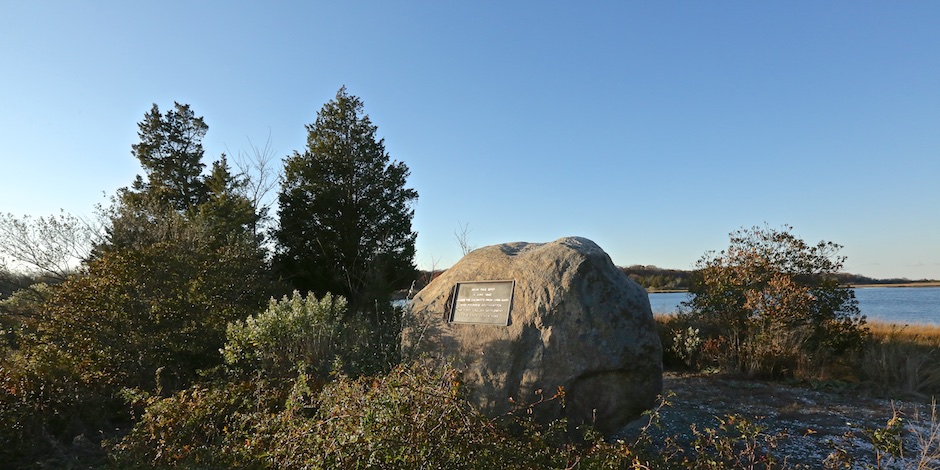
Conscience Point — June 12, 1640 — North Sea
A large rock monument indicates the area where 80 English Puritans from Lynn, Massachusetts, landed on June 12, 1640. These pioneers, seeking religious freedom, then moved farther inland and established the hamlet of Southampton — the first English settlement in New York. Conscience Point Park is adjacent to the Conscience Point National Wildlife Refuge with 60 acres of maritime grasslands and miles of nature trails. — Town of Southampton.
______________________________________________

Andross Patent, 1676, & Dongan Patent, 1686
Thomas Dongan (1634-1715), Governor of the Province of New York who executed land grants—called the Dongan Patents—that established several towns throughout New York State, including Southampton. They set up Town Trustees as the governing bodies with a mission of managing common land for the common good.
Edmund Andross (1637-1714) Arrived as Governor of New York in 1674 and executed a patent that established the three eastern towns as part of New York against the protests of residents who wished to maintain their union with New England.
— Southampton Historical Museum.
www.southamptonhistoricalmuseum.org
______________________________________________

Mill Pond, Water Mill
———————————————————
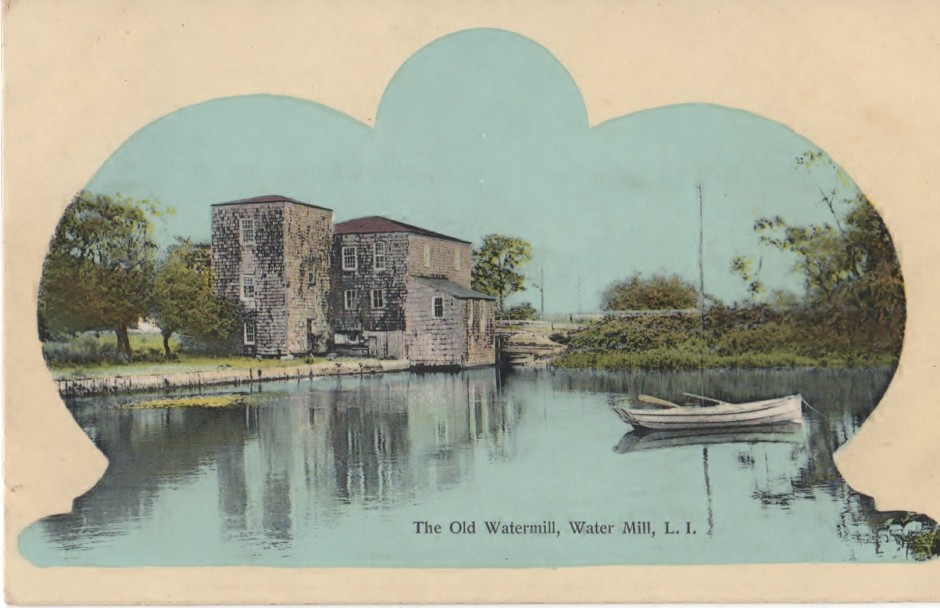
Archival postcard courtesy of the Southampton Historical Museum.
THE WATER MILL
The history of the water mill begins with Edward Howell who came to Southampton in 1640 with English colonists from Lynn, Massachusetts. Howell had owned a water mill on a pond in Lynn so it was not surprising that he settled on a 100-acre pond (now Mill Pond) three miles from Southampton for his new venture.
Howell – the wealthiest citizen of the new colony and its magistrate – got the town to give him 40 acres on the pond and to provide labor and money to support his project. The mill was built and millstones hewn from two boulders found in the moraine north of the site. Oral history places this first mill, which was probably grinding by 1644, several hundred yards north of its current site on Mill Creek. The Water Mill was operated as a grist and fulling mill, and passed through several ownerships, until it was restored and opened as a museum in the 20th century. — Water Mill Museum.
New York State & National Registers of Historic Sites.
Visit: www.watermillmuseum.org
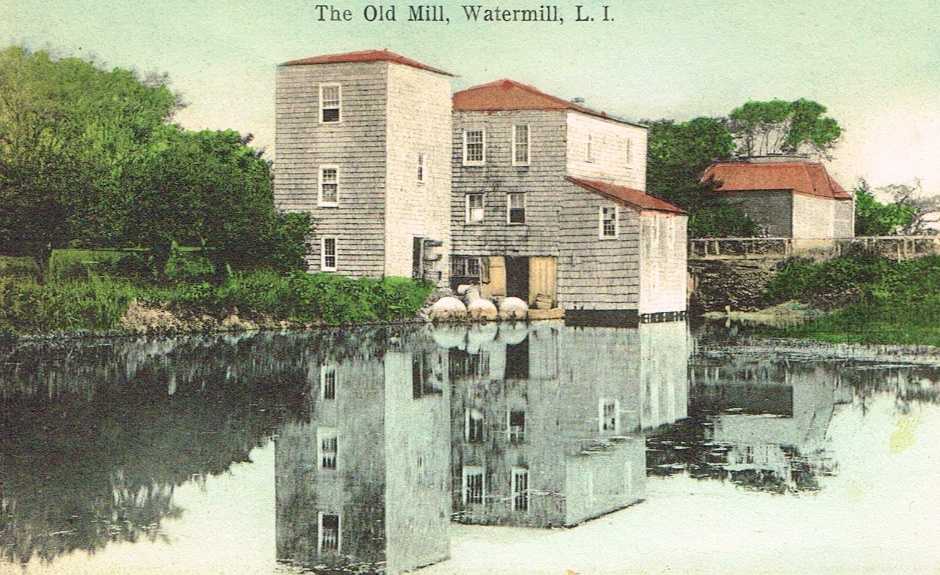
Archival postcard courtesy of the Southampton Historical Museum.
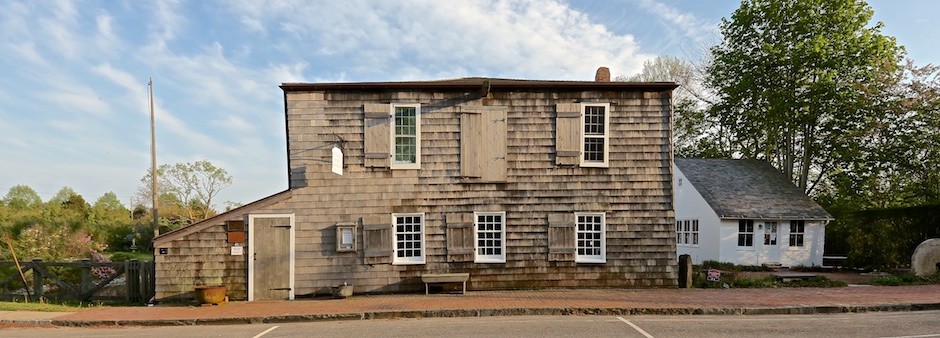
Water Mill Museum, East Elevation, May 2015.
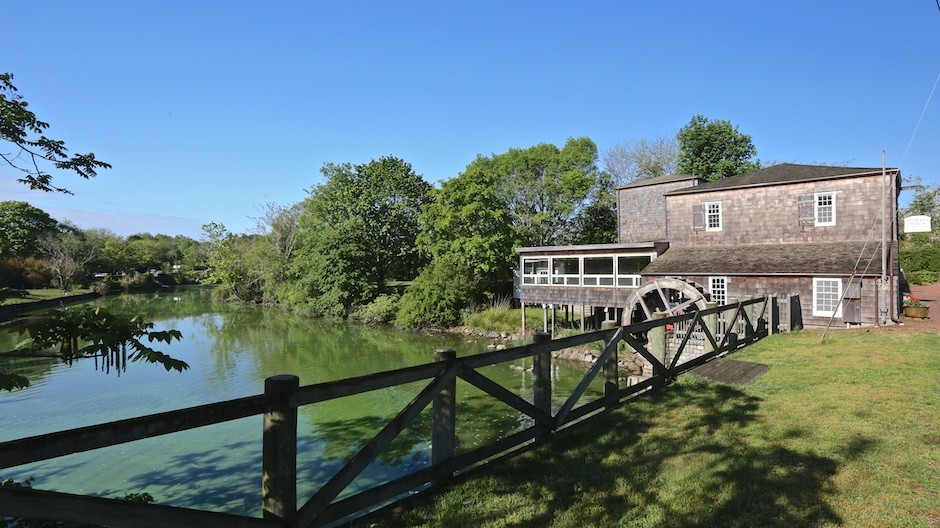
Water Mill Museum, South Elevation, June 2015.
______________________________________________
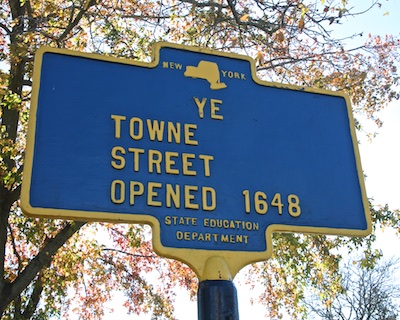 Ye Towne Street was opened in 1648 when the settlement relocated eastward. It followed the same path from the ocean northward that Main Street does today. On either side of the street were the cleared home lots of the settlers. The earliest houses were built at the south end, including the Halsey House, 1683. — Historic Division, Southampton Town Clerk.
Ye Towne Street was opened in 1648 when the settlement relocated eastward. It followed the same path from the ocean northward that Main Street does today. On either side of the street were the cleared home lots of the settlers. The earliest houses were built at the south end, including the Halsey House, 1683. — Historic Division, Southampton Town Clerk.
In 1648 the whole Southampton colony moved from Olde Towne, near the present site of Southampton Hospital, to Towne Street (Main Street today), where every householder was allotted a “home lott.” — Mary Cummings: Southampton, Images of America / Arcadia Publishing.
______________________________________________
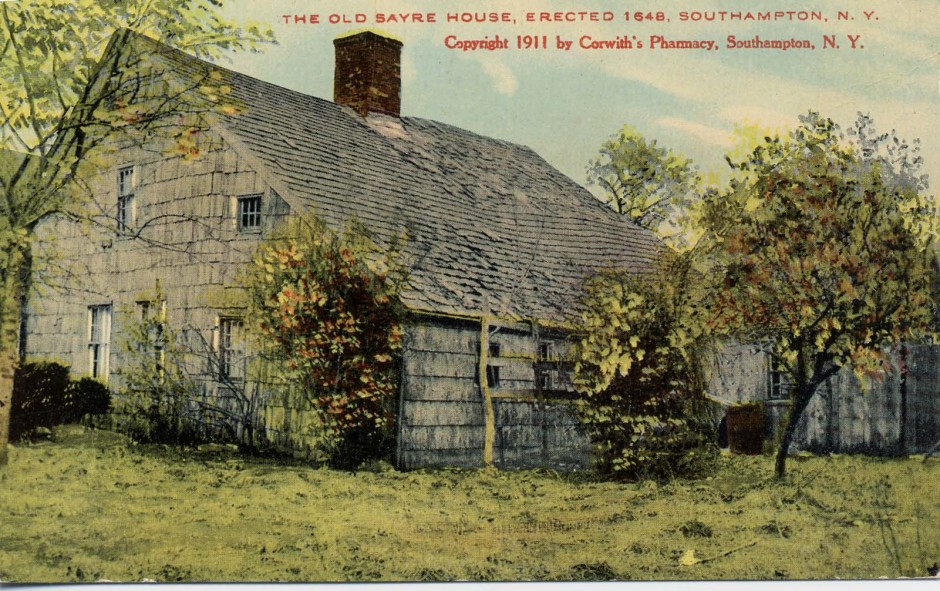
Sayre House, 1648, Southampton. Demolished 1912.
“Old Sayre House” was built in 1648 by Thomas Sayre, one of the eight original founders of the Southampton colony. The Sayre House stood on Main Street until it was thought to be the oldest wooden building on the American continent and possibly in the world. In 1912 it was condemned as a fire hazard and torn down, and thus one of the last reminders of the seventh-century village was eliminated. — Mary Cummings: Southampton, Images of America / Arcadia Publishing.
______________________________________________
 JOBS LANE, 1664, SOUTHAMPTON
JOBS LANE, 1664, SOUTHAMPTON
It may seem strange that the Lane was not opened until sixteen years after Main Street (Ye Towne Street) was laid out–in 1648. The reason is that an impassable swamp extended north from Lake Agawam. The first dry-shod crossing to the western part of the Village was at Jagger’s Lane–about a quarter mile north of Job’s. Later, a portion of the swamp was filled in and Job’s Lane became the thoroughfare to the west. — The Tercentenary of Job’s Lane, Southampton, Long Island, 1664–1964.

______________________________________________
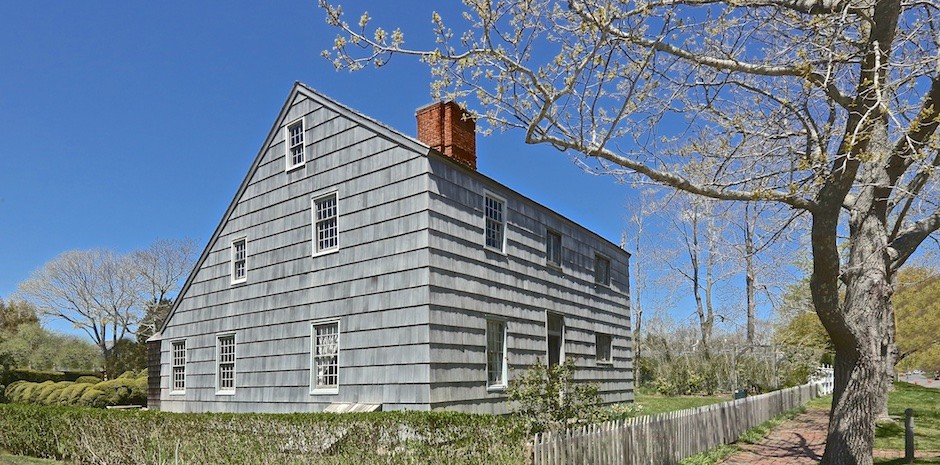
Halsey House, 1683, Southampton
“Thomas Halsey and his family, along with eight other Puritan families, left Lynn, Massachusetts seeking religious freedom. They landed in Southampton in 1640 and settled on Old Town Road. Thomas Halsey and his wife Elizabeth homesteaded this property in 1648. This saltbox-style house was built beginning in 1680.” — Southampton Historical Museum sign at site.
Captain Isaac Halsey inherited his father’s Main Street home lot and house in 1689. Evidence in the timber frame suggests that between about 1720 and about 1740, Isaac Halsey undertook an extensive remodeling. First he took off the roof frame, demolished the north lean-to, demolished the west lean-to and removed most of the framing of the chimney bay. Isaac Halsey retained only the two-story, nearly cubic frame (18′ wide x 18′ deep x 16′ high) of the hall and hall chamber. Captain Isaac Halsey revolved this small box frame to face east toward Main Street. He then rebuilt the chimney-bay, added a two-story south addition, built a larger rear lean-to and covered the whole with a new roof. — Robert Hefner, Historic Structure Report.
Visit: AAQ Landmark — The Thomas Halsey Homestead
Visit: AAQ Portfolio / Preservation — Historic Structure Report by Robert Hefner, 2014
www.southamptonhistoricalmuseum.org
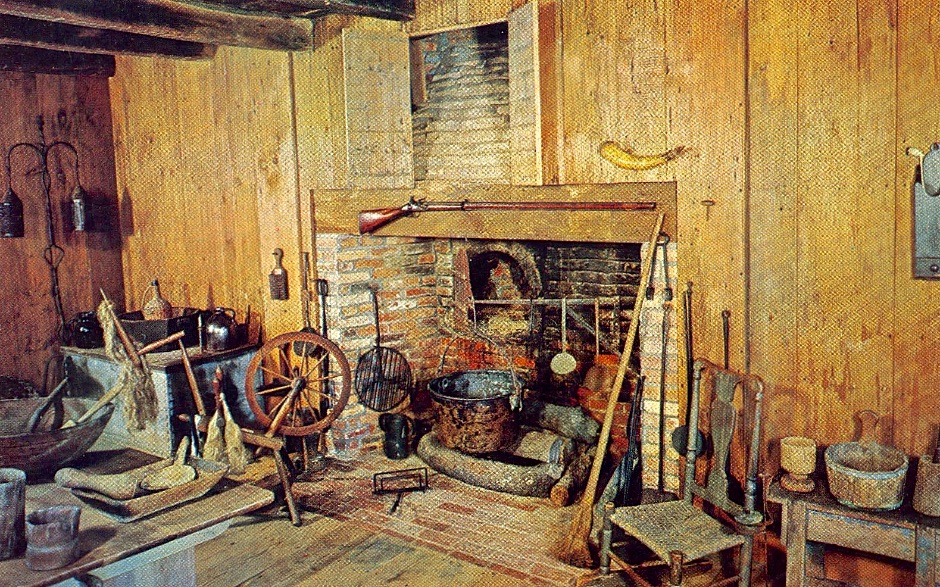
Halsey House kitchen. Archival postcard courtesy of the Southampton Historical Museum.

June 29, 2018
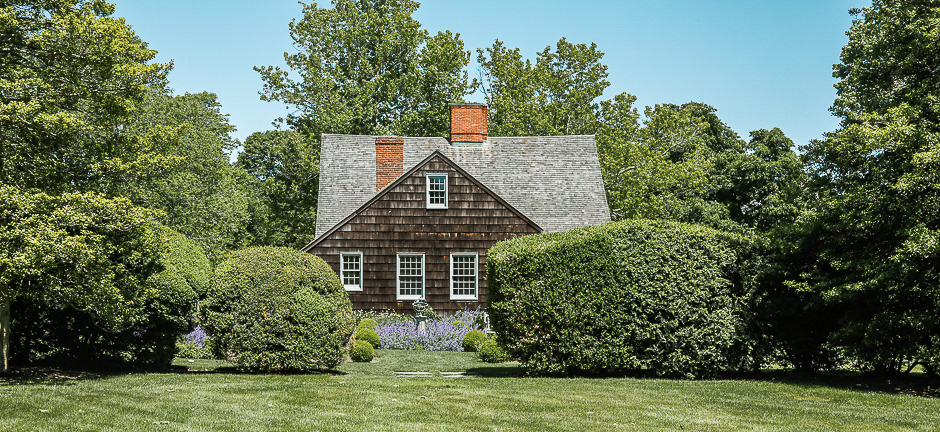
June 12, 2018
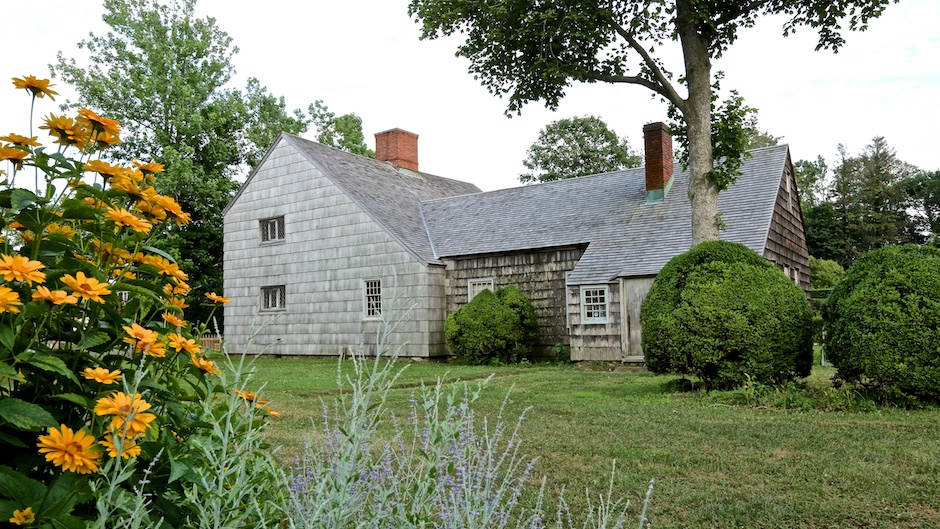
______________________________________________

Old Southampton Burying Ground, 1682 / 1897
The final resting place of Southampton’s earliest settlers, the Old Southampton Burying Ground
is a 2-acre field largely empty of headstones due to the custom of using wooden grave markers for all but the wealthiest of the town’s inhabitants. Approximately 50 headstones and footstones survive today, some of them the oldest in Southampton Town. The earliest dates from 1682, the most recent from 1897. Among the most remarkable of the monuments are massive brownstones carved in the “heraldic” style which preserve the coats-of-arms of the Howell family, prominent early settlers. The site is one of ten historic burying grounds owned and maintained by Southampton Town. — Historic Division, Southampton Town Clerk.
Historic Division, Southampton Town Clerk
______________________________________________
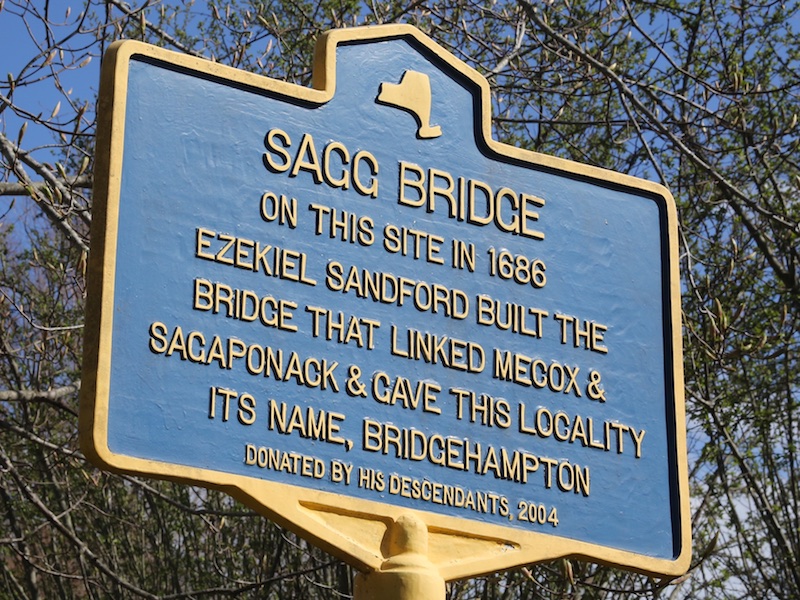
Sagg Bridge, 1686, Bridgehampton

October 6, 2015

Archival postcard courtesy of the Bridgehampton Historical Museum.
______________________________________________

Pelletreau Silver Shop, 1686, Southampton
The oldest continuously open shop in the Western Hemisphere. Built in 1686 as a dry goods store, it was purchased in 1717 by Francis Pelletreau who immigrated to Southampton from New York City in 1717 to develop his business producing oil and candles from whales that drifted to the Southampton beaches. His grandson Elias Pelletreau occupied the building between 1750 and 1810 making jewelry, shoe buckles, tankards, silverware, etc. He became well-known as a silversmith selling his wares to clients between Connecticut and New Jersey. He is considered a local hero for his role as Captain of the Suffolk County Militia and his financial backing of and participation in the American Revolution. His son, nephew and grandson continued the tradition of silversmithing into the 19th century. The shop is now occupied by Master Jeweler Eric Messin who gives tours of the building and conducts workshops in jewelry making. — Southampton Historical Museum.
www.southamptonhistoricalmuseum.org

______________________________________________

Pierson-Albright House, 1692, Sagaponack
Constructed as early as 1692, the Pierson-Albright House is a three-bay “salt box” retaining a modillioned cornice, six-over-six sash and a shed-roofed entryway supported on piers. The house was built by Theodore Pierson; subsequent owners included Andrew Barron, Lemuel and Daniel Howell Haines, and Henry L. Topping. — Historic Division, Southampton Town Clerk.
Historic Division, Town of Southampton
______________________________________________
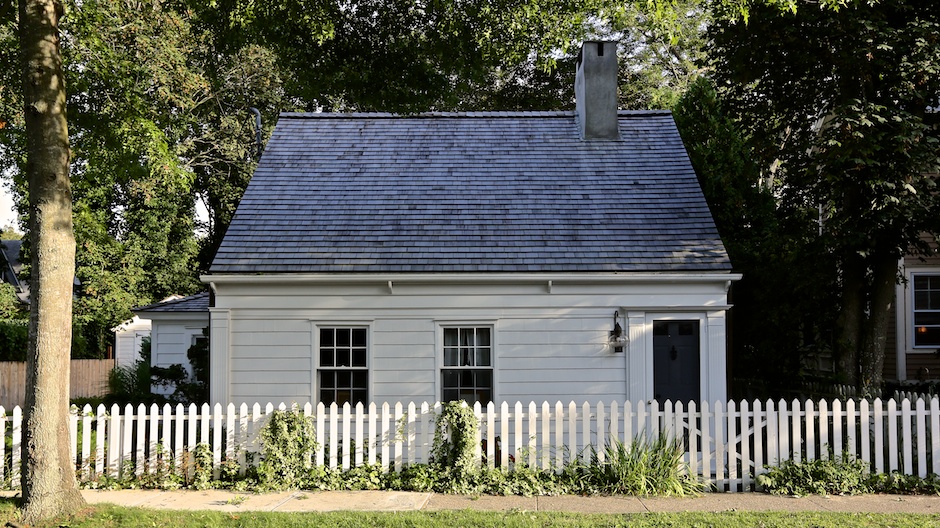
Hand House, Sag Harbor, 1693.
Originally built in Sagaponack, this cottage has been moved five times. The overall proportions, roof pitch, and three-bay, side entrance design of the colonial “half house” has been retained in this 17th century building’s restoration. — Society for the Preservation of Long Island Antiquities.
______________________________________________
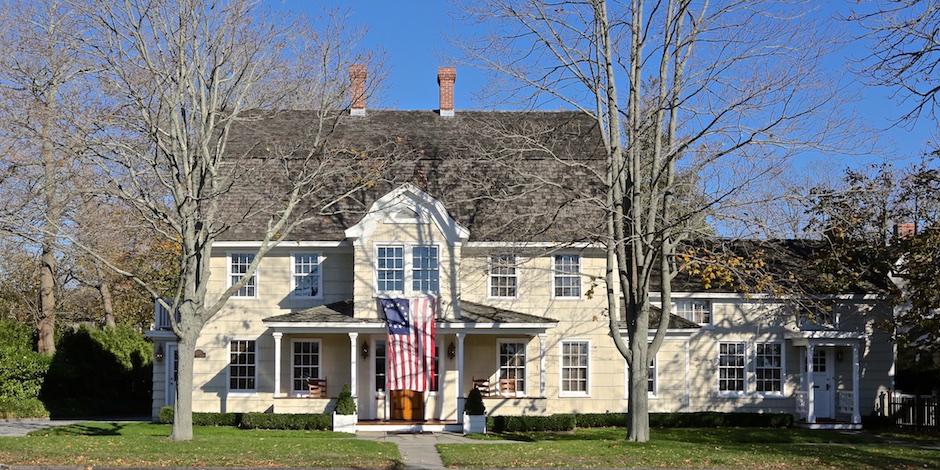
1708 House, Southampton. Original cellar dates from 1708.
When the village moved from Old Town to Main Street in 1648, Jonas Bower built his house on this site and the basement has survived to become the 1708 House’s wine cellar. When he gave a tour a few years ago, the owner Skip Ralph painted a picture of conspiratorial patriots gathered in the cellar to exchange information on the British during the occupation and pointed out the rough stone wall that survives. A Bower descendant built the large house over the original cellar in 1708 and later owners, including Hunttings and Fosters expanded it. The restoration by the Ralphs was very meticulous. The NY Times called it “a cross between a luxury getaway and a museum.” — Mary Cummings, Southampton Historical Museum.
www.southamptonhistoricalmuseum.org
—————
Vist AAQ Resource / Accommodation: 1708 House, Southampton / Bed & Breakfast
______________________________________________
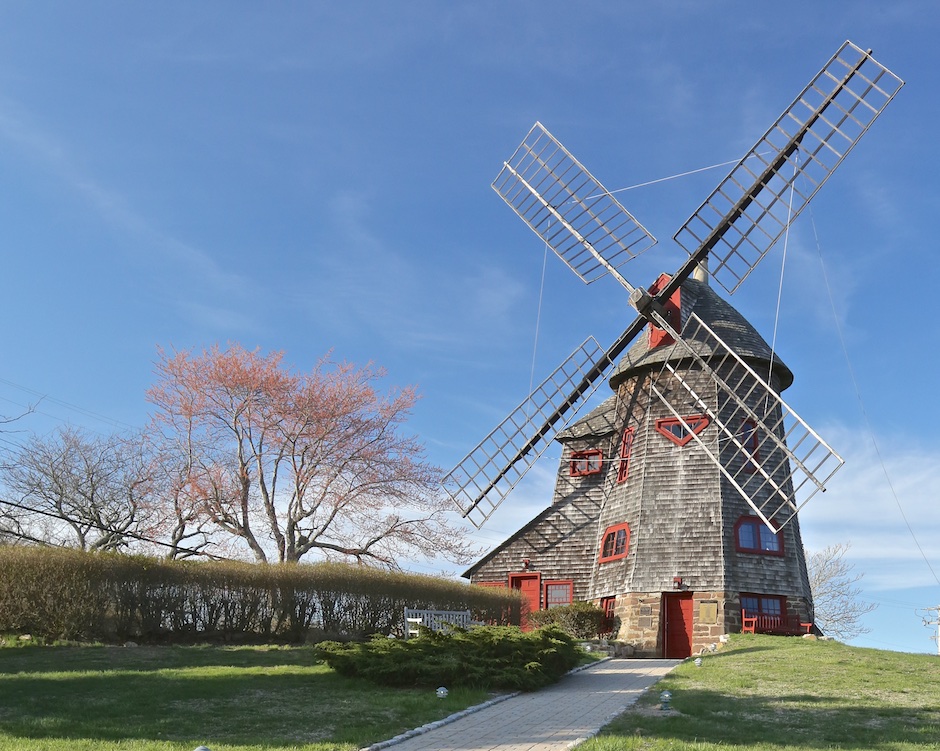
Windmill, c. early-1700s, Southampton
Located on the grounds of Southampton College, this wood shingle-clad windmill was constructed in the early 1700s and moved to its present location in 1890, where it became part of the Clafin estate. The estate, along with the windmill, was sold after World War II and became the Tucker Mill Inn. Playwright Tennessee Williams rented the windmill for the summer in the 1950s. It was purchased by the college in 1963 and restored to its present condition in 1991. The context of the windmill and mansion has been substantially altered since the time of their use as an estate due to the existence of the surrounding college campus buildings and the presence of a large transmission tower, however the buildings retain historic significance as well as their physical relationship to each other. — Town of Southampton.
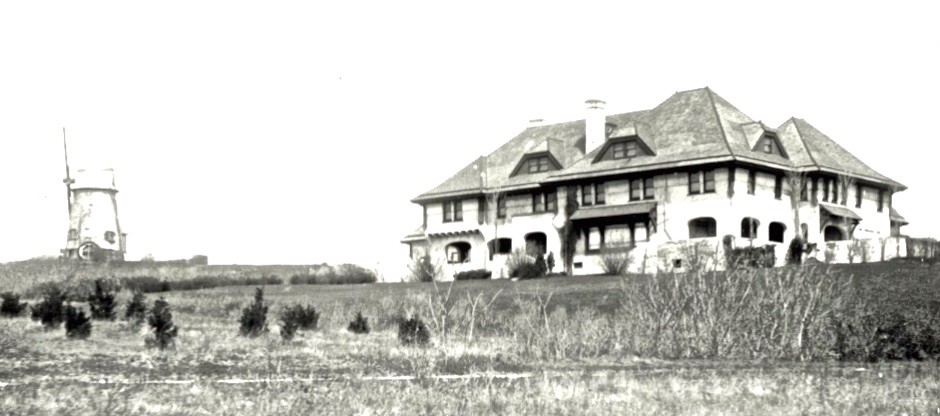
Archival postcard courtesy of the Southampton Historical Museum.
______________________________________________

Mary Post House, 1730s, Quogue
The “Mary Post House” is one of the five earliest houses in Quogue and is said to
have been built in the 1730s. It originally stood to the south of its present location on land belonging to Jonathan Cook, who moved to Quogue from Southampton and bought Quogue land in the early 1730s. The property on which the house stands was transferred from the Cook family to Post family ownership in 1817, hence the name. — Historic Division, Southampton Town Clerk.
Historic Division, Town of Southampton
______________________________________________
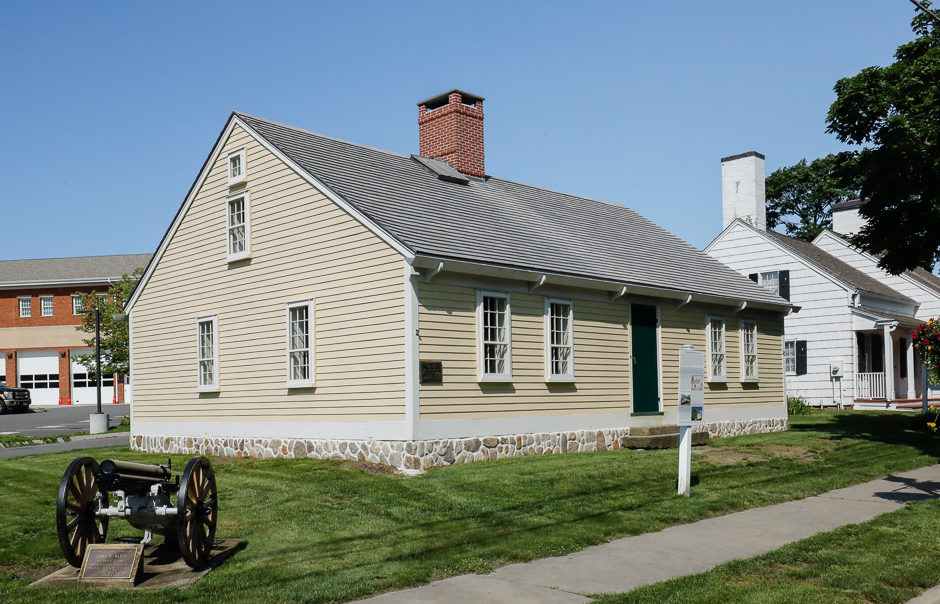
Foster-Meeker House, 1735, Westhampton Beach. Future home of the Foster-Meeker Heritage Center.
The Foster-Meeker Heritage Center is a reconstruction of the oldest surviving building in Westhampton Beach, originally known as Ketchaponack. The area was initially settled in the 1730s after the original Southampton community expanded westward following the 1666 Quogue Purchase and 1683 land division. The original Foster-Meeker House, of which an extensive intact framing system remains, was constructed about 1735 and likely used by early settlers.
Architecturally, the Foster-Meeker House was significant as a mid-1700s post-and-beam Cape Cod-type dwelling. Characteristically low to the ground and compact in appearance, the Cape Cod dwelling expressed a unique response among early Long Island settlers to an exposed environment with high winter winds, hurricanes, and other natural coastal phenomena.
The Westhampton Beach Historical Society, recognizing that the Foster-Meeker House was one of the oldest structures in the Village, documented the building, secured funding, and moved the House to its current location when it was threatened with demolition in 2008. — Westhampton Beach Historical Society.
New York State & National Register of Historic Places
______________________________________________
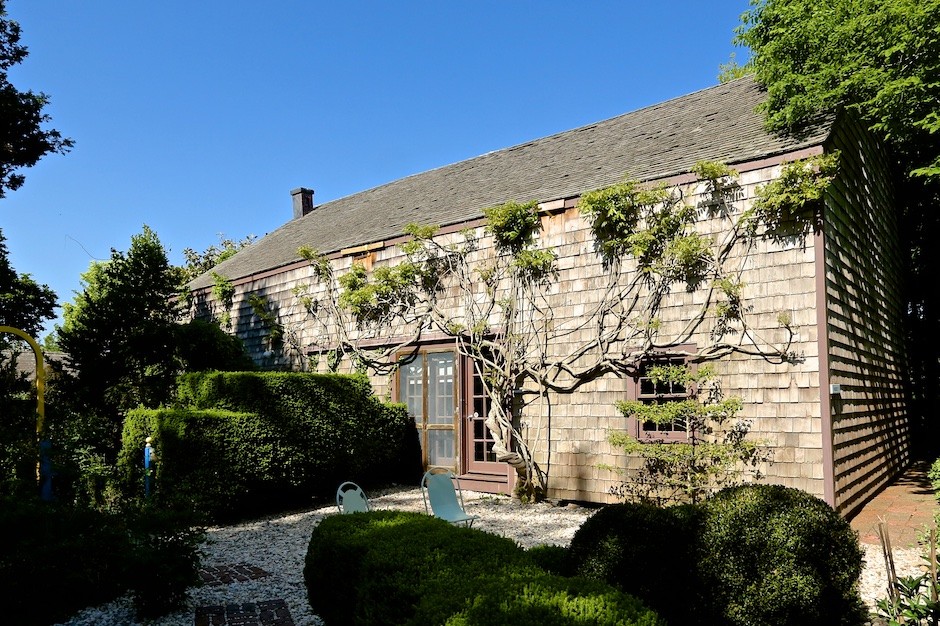
Barn at Madoo Conservancy, 1740, Sagaponack
The Madoo Conservancy preserves two barns and two houses, one of which was
converted for use as an artist’s studio. The barns are of greater architectural interest due to their antiquity, one constructed c. 1740 and the other c. 1850. The earlier is preserved on its original foundation. The gardens on the property were developed by artist and poet Robert W. Dash beginning in 1967. Today, the Madoo Conservancy is dedicated to the preservation and interpretation of the gardens and historic structures on the property. — Historic Division, Southampton Town Clerk.
Historic Division, Town of Southampton
Madoo Conservancy’s Mission: The Madoo Conservancy is dedicated to the study, preservation, and enhancement of madoo, the ever changing, horticulturally diverse garden with historic structures established in 1967 by artist, gardener, and writer Robert Dash in the village of Sagaponack, New York. At Madoo, a unique living tribute to the artistic imagination of its founder, we seek to continually engage, educate, and inspire our visitors within this ever-changing, entirely organic environment. —– Madoo Conservancy.

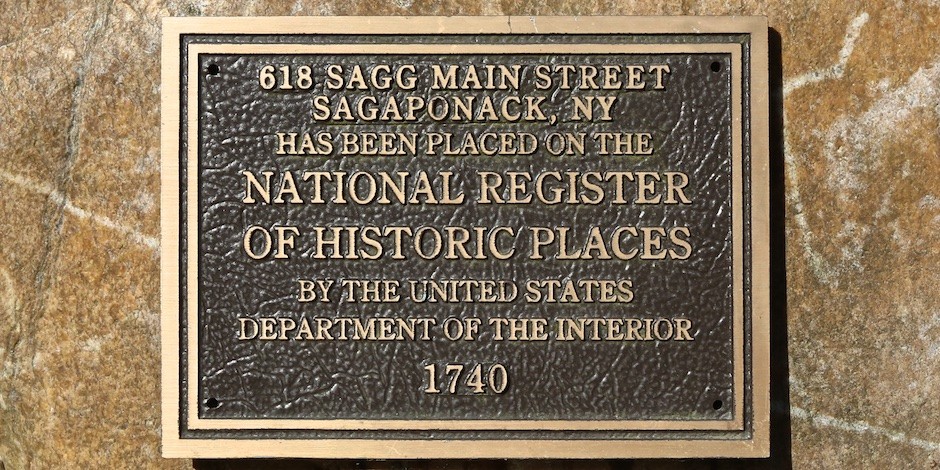
______________________________________________
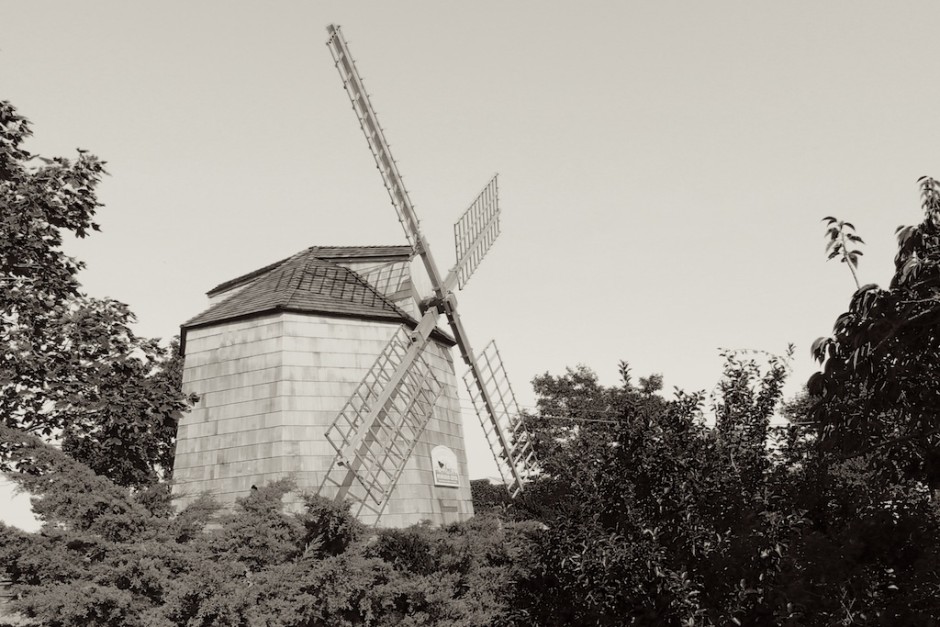
Windmill Replica (1966), Original 1760, Sag Harbor
“Erected by the citizens of Sag Harbor in the year nineteen hundred sixty-six as an historic memorial to the great whaling industry which is part of our heritage. The original windmill was erected in 1760. This reconstruction was completed under the auspices of the 1966 Old Whalers Festival.” — John A. Ward, Jr. Chairman, plaque at site.
______________________________________________
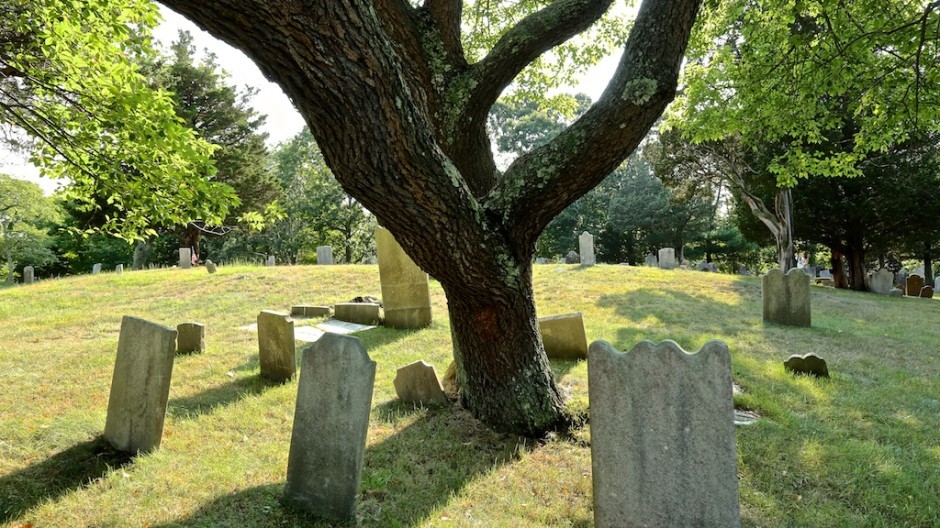
Old Burial Ground, 1767 – 1870
Although adjoining the Presbyterian Church, the Old Burying Ground was a village cemetery, with the first burials the infant children of Tory Innkeeper, James Howell. They were buried in 1767 in unmarked graves. Used for about 100 years, the Old Burying Ground is the resting place of Sag Harbor’s early residents, Revolutionary War Patriots, Whaling Captains, Portuguese Seamen, African Americans, and the founding fathers of the village. The last person to be buried here was Hetty Parker, who died in 1870. — Placard, Old Burying Ground.
______________________________________________
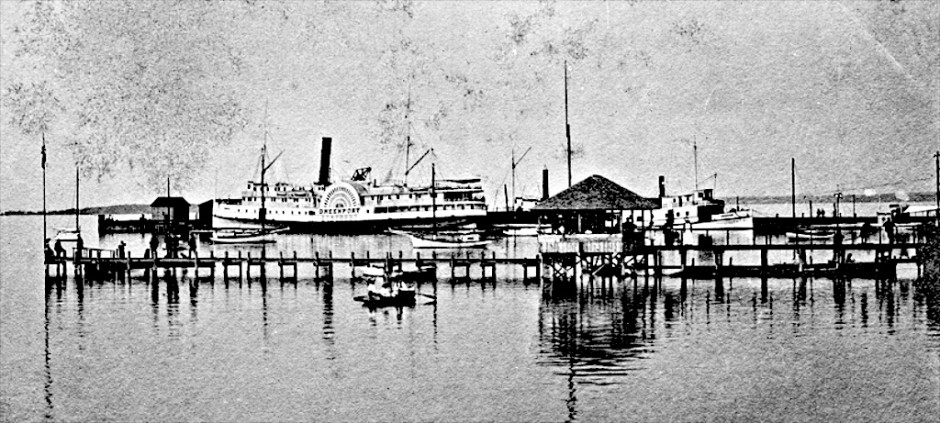
Postcard showing the first location of the Sag Harbor Yacht Club when it was located (1899-1913) west of Long Wharf (pictured in the background). It then moved east of Long Wharf to its present location. The Steamboat “Greenport” is docked at Long Wharf. Archival postcard courtesy of the Sag Harbor Historical Society.
Long Wharf, 1771, Sag Harbor
Since 1771, Long Wharf has been Sag Harbor’s hub. It was rebuilt and extended for the whaling trade in 1821. In its heyday ships were lined up six deep, preparing for voyages lasting six months to two years, and traveling as far as the Pacific. From the Wharf to Bay and West Water Streets, the harbor bustled with businesses serving the trade–sail makers, ropewalks, foundries, and coopers. They all disappeared along with the whaling trade, or were snuffed out by notorious fires that engulfed downtown Sag Harbor, notably in 1817, 1845 and 1877. Sag Harbor was an international trading port and in 1789 designated New York State’s first Port of Entry. — Sag Harbor Historical Society.

Long Wharf, June, 2015
____________________________________________________________________________________

Art & Architecture Quarterly / East End thanks the following individuals/organizations for images, information and/or assistance in the preparation of the four portfolios:
Mary Cummings, Archivist, Southampton Historical Museum for archival photos, postcards & information, and author of Southampton / Images of America / Arcadia Publishing.
Julie Greene, Collections Manager/Curator/Archivist at the Bridghampton Historical Museum, and author of Bridgehampton / Images of America / Arcadia Publishing.
Sally Spanburgh, Chairperson of the Town of Southampton Landmarks and Historic Districts Board, and author of The Southampton Cottages of Gin Lane / The History Press
Zach Studenroth, Town Historian, Historic Division, Southampton Town Clerk for Walking & Driving Tour Guides prepared in celebration of the Town of Southampton’s 375th Anniversary.
Anne Surchin, Houses of the Hamptons, co-authored with Gary Lawrance / Acanthus Press.
Town of Southampton / Historic Resources Survey Prepared by AKRF, 2014
Water Mill Museum, Water Mill
As well as, Stephanie Davis, Marsha Kenny, Leigh Phillips and Eric Woodward.
————————————————-
All photographs, except archival photographs and postcards, copyright Jeff Heatley.
————————————————-
AAQ / Resource / Education / Books
Town of Southampton / Historic Division — Click Here.
———————————–
Visit Related Town of Southampton Portfolios:
Southampton Town, 1777 — 1865: Early Republic & Economic Expansion
Southampton Town, 1866 — 1915: Post-Civil War Prosperity & Immigration
Southampton Town, 1916 — 2016: Modern Era
~~~~~~~~~~~~~~~~~~~~~~~~
Suggestions / Comments: editors@aaqeastend.com
______________________________________________
